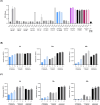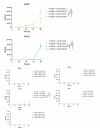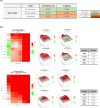VLX600, an anticancer iron chelator, exerts antimicrobial effects on Mycobacterium abscessus infections
- PMID: 40539807
- PMCID: PMC12323642
- DOI: 10.1128/spectrum.00719-25
VLX600, an anticancer iron chelator, exerts antimicrobial effects on Mycobacterium abscessus infections
Abstract
Mycobacterium abscessus presents significant clinical challenges due to its intrinsic and acquired resistance to antibiotics, resulting in prolonged treatments and poor patient outcomes. Addressing the urgent need for novel therapeutics, this study explores the antimicrobial potential of VLX600, originally developed as an anticancer agent, against M. abscessus. Screening a library of 3,200 clinically evaluated compounds identified VLX600 as a potent antimicrobial with minimal cytotoxicity. VLX600 demonstrated inhibitory effects against various strains of M. abscessus with minimum inhibitory concentrations of 4 µg/mL-16 µg/mL. It also remained effective in intracellular M. abscessus in host cells and exhibited broad-spectrum activity against other bacterial species, including Escherichia coli, Staphylococcus aureus, and Pseudomonas aeruginosa. The antimicrobial activity of VLX600 was abrogated by supplemental iron, indicating a mechanism dependent on iron chelation. VLX600 significantly reduced bacterial burdens and inflammation in a murine model of pulmonary M. abscessus infection. Additionally, synergistic effects were observed when VLX600 was combined with conventional antibiotics such as amikacin and clarithromycin in vitro. These findings highlight VLX600 as a promising candidate for repurposing as an antimicrobial agent against M. abscessus, warranting further clinical investigations.IMPORTANCEMycobacterium abscessus is an opportunistic pathogen that commonly causes pulmonary infections in cystic fibrosis patients. These infections are notoriously difficult to treat due to high levels of antibiotic resistance of M. abscessus, resulting in low cure rates. In this study, we identified a novel antibiotic candidate, VLX600, through high-throughput screening of 3,200 clinical compounds and demonstrated that VLX600 inhibits the growth of M. abscessus by depriving it of ferric and ferrous ions. This study highlights the potential of iron chelators as antimicrobial agents against M. abscessus infections. Since iron is an essential nutrient for the growth of many bacteria, the use of iron chelators could be extended to other infectious diseases. We hope this research will inspire further studies aimed at developing iron chelators as a novel class of antimicrobial agents.
Keywords: Mycobacterium abscessus; VLX600; antibiotics; drug repositioning; iron chelator.
Conflict of interest statement
J.-J. Yim has served as the overall or institutional principal investigator for clinical trials related to non-tuberculous mycobacterial pulmonary disease sponsored by LigaChem Biosciences, Insmed, and AN2 Therapeutics. Additionally, he has received several drugs free of charge as a principal investigator for previous trials related to tuberculosis from Pfizer, Otsuka, and Yuhan.
Figures





Similar articles
-
Antibiotic treatment for non-tuberculous mycobacteria lung infection in people with cystic fibrosis.Cochrane Database Syst Rev. 2025 Mar 27;3(3):CD016039. doi: 10.1002/14651858.CD016039. Cochrane Database Syst Rev. 2025. PMID: 40145528
-
The sesquiterpene lactone estafiatin exerts an anti-inflammatory effect against Mycobacterium abscessus infection by regulating interleukin-1 beta production.Phytomedicine. 2025 Oct;146:157080. doi: 10.1016/j.phymed.2025.157080. Epub 2025 Jul 22. Phytomedicine. 2025. PMID: 40729891
-
Preclinical murine models for the testing of antimicrobials against Mycobacterium abscessus pulmonary infections: Current practices and recommendations.Tuberculosis (Edinb). 2024 Jul;147:102503. doi: 10.1016/j.tube.2024.102503. Epub 2024 Mar 19. Tuberculosis (Edinb). 2024. PMID: 38729070 Free PMC article. Review.
-
The gene MAB_2362 is responsible for intrinsic resistance to various drugs and virulence in Mycobacterium abscessus by regulating cell division.Antimicrob Agents Chemother. 2025 Feb 13;69(2):e0043324. doi: 10.1128/aac.00433-24. Epub 2024 Dec 19. Antimicrob Agents Chemother. 2025. PMID: 39699214 Free PMC article.
-
Evaluation of mlstverse system for accurate subspecies identification and drug resistance prediction in Mycobacterium abscessus species.Microbiol Spectr. 2025 Sep 2;13(9):e0064325. doi: 10.1128/spectrum.00643-25. Epub 2025 Jul 31. Microbiol Spectr. 2025. PMID: 40742165 Free PMC article.
References
MeSH terms
Substances
Grants and funding
LinkOut - more resources
Full Text Sources
Medical

